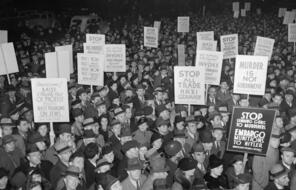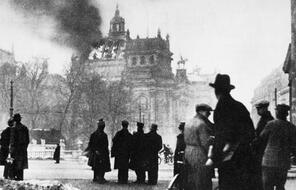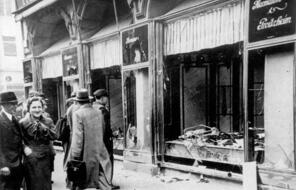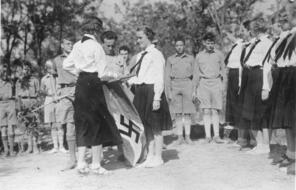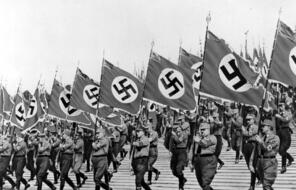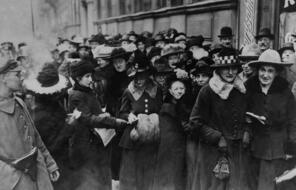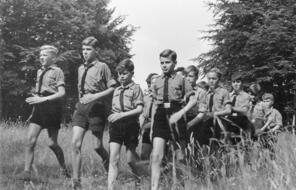First Encounters in the Americas
Subject
- History
Language
English — USUpdated
When two people meet for the first time, each takes stock of the other, often focusing on differences. Scholar Martha Minow warns that difference always “implies a reference: difference from whom? I am no more different from you than you are from me. A short person is different only in relation to a tall one; a Spanish-speaking student is different in relation to an English-speaking one. But the point of comparison is often unstated.” 1 By identifying unstated points of comparison, we can examine the relationships between those who have the power to assign labels of difference and those who lack that power.
The first meetings between Europeans and the Indigenous Peoples of the Americas 2 illustrate Minow’s argument. Historians Peter Carroll and David Noble describe those encounters:
[On] an otherwise ordinary autumn day shortly after sunrise, the Arawak inhabitants of the Caribbean Islands noticed strange ships sailing on the horizon, much larger than their dugout canoes. As these ships moved closer and closer, they saw strange-looking people with light skins aboard, making odd gestures. The Arawak youths stood at the banks hesitantly, and then some of the braver men began swimming toward the mysterious boats.
These strangers offered the Arawak red-colored caps, glass beads, and other curious trifles. In exchange, the Arawak brought parrots, cotton skeins, darts, and other items. Then the strangers drew out swords, which the Arawak, in ignorance, grasped by the blades, cutting themselves. It was a symbolic act, this inadvertent drawing of blood. For the Arawak and the strangers looked at the world from opposite angles, and both were fascinated by what the other was not. 3
To the Arawak, the newcomers were so obviously different in language, dress, and color that the Arawak doubted that the Europeans were human beings. “They believe very firmly,” wrote Christopher Columbus after his first voyage to the Americas, “that I, with these ships and people, came from the sky.” 4 Other Indigenous Peoples reacted in similar ways to their first encounters with Europeans.
Columbus and other Europeans had their own misconceptions. They mistakenly believed that the Arawak were “Indians.” Carroll and Noble write:
This misconception originated in Columbus’s basic error (which he himself never realized) in thinking that in sailing westward from Europe he had reached the Indies [in Asia], which were the true object of his voyage. To Columbus, it was literally inconceivable that he had found previously unknown lands. Like other Europeans of his time, he believed firmly in the completeness of human knowledge. What he saw, therefore, he incorporated into his existing worldview, and the Native Americans thereby became, to the satisfaction of most Europeans, simply Indians. 5
In describing the “Indians,” Europeans focused not on who they were but on who they were not. They then went on to describe what the Indigenous Peoples did not have. Amerigo Vespucci, for whom the Americas are named, described the “Indians” as neither Muslims nor Jews. He noted that they were “worse than heathen; because we did not see that they offered any sacrifice, nor yet did they have a house of prayer.” John Winthrop, an Englishman who helped found the Massachusetts Bay Colony, justified his claims to the Indigenous Peoples’ land by arguing that they did not mark their ownership of it in ways that Europeans recognized. He wrote that they “enclose no land, neither have they any settled habitations, nor any tame cattle.” 6
To many newcomers, the Indigenous Peoples were not only “backward” but also dangerous. In historian Ronald Takaki’s words, “They represented what English men and women in America thought they were not—and, more important, what they must not become.” 7 Colonial leaders warned that colonists must strictly adhere to the laws and moral guidelines that defined their communities; otherwise they would allow themselves to become “Indianized.” Increasingly, “to be ‘Indianized’ meant to serve the Devil.” It also meant to be “decivilized, to become wild men.” 8 After all, the English viewed "Indians" as people living outside of “civilization.”
Such ideas were rooted at least in part in religious beliefs. As Carroll and Noble point out in their description of Spanish explorers,
Europeans in the age of Columbus saw themselves as Christians, the most spiritually pure people in creation. This ethnocentric idea found reinforcement in the ideals of the Roman Catholic Church, which claimed to be a universal spiritual community. Yet this ideology clearly excluded such religiously different people as Muslims, against whom Christians had waged holy wars for centuries, and Jews, who remained outsiders throughout European society. Believing in a single unitary religion, members of the Catholic Church viewed [nonbelievers] as suitable either for conversion to the true faith or worthy only of death or enslavement. Such religious attitudes shaped the Europeans’ relations with Africans as well as Native Americans. 9
Such attitudes were not limited to Europeans who were Catholic. They were shared by Protestants as well.
Relations between the Indigenous Peoples of the Americas and the Europeans were also shaped by the fierce competition among European nations for wealth and power. As Europeans took control of more and more of the Americas, millions of Indigenous People were killed. Countless others were pushed into the interior of both continents. Still others were forced into slavery.
Connection Questions
- Find words that Europeans used to describe Indigenous Peoples of the Americas. What do those words imply about how Europeans understood the new people they encountered?
- What misconceptions did the Arawak seem to have about the Europeans who arrived on Christopher Columbus’s ships? What misconceptions did Columbus and other Europeans have about the Indigenous Peoples they encountered? Why did both groups have so many misconceptions? What effect did these misconceptions have on how Europeans and Indigenous Peoples thought about each other?
- Sociologist Kai Erikson writes: “One of the surest ways to confirm an identity, for communities as well as for individuals, is to find some way of measuring what one is not.” In what ways did Europeans define Indigenous Peoples of the Americas according to that logic? What purpose did such thinking serve for these newcomers to North America? What might be the effects of a negative identity—of defining others by what they are not?
- Have you ever been defined by what you are not? If so, how did it affect the way you viewed yourself? Why do you think that people so often focus on differences rather than similarities when they meet others for the first time?
- What factors shape your initial understanding of unfamiliar people, places, and things that you encounter? What happens when you meet a person or group for whom you have no category? How difficult is it to avoid forming misconceptions about the unfamiliar?
- 1Martha Minow, Making All the Difference: Inclusion, Exclusion, and American Law, rev. ed. (Ithaca, NY: Cornell University Press, 1991), 22.
- 2The Indigenous Peoples of the Americas is not a single homogenous group. This term—as well as terms used in the United States such as "Native American" and "American Indian"—refers to hundreds of culturally diverse groups who inhabited the Americas before Europeans settled there.
- 3Peter N. Carroll and David W. Noble, The Free and the Unfree: A Progressive History of the United States, 3rd ed. (New York: Penguin, 2001), 34.
- 4Peter N. Carroll and David W. Noble, The Free and the Unfree: A Progressive History of the United States, 3rd ed. (New York: Penguin, 2001), 34–35.
- 5Peter N. Carroll and David W. Noble, The Free and the Unfree: A Progressive History of the United States, 3rd ed. (New York: Penguin, 2001), 35–36.
- 6Peter N. Carroll and David W. Noble, The Free and the Unfree: A Progressive History of the United States, 3rd ed. (New York: Penguin, 2001), 36.
- 7Ronald Takaki, A Different Mirror: A History of Multicultural America, 2nd ed. (New York: Back Bay Books, 2008), 34.
- 8Ronald Takaki, A Different Mirror: A History of Multicultural America, 2nd ed. (New York: Back Bay Books, 2008), 42–43.
- 9Peter N. Carroll and David W. Noble, The Free and the Unfree: A Progressive History of the United States, 3rd ed. (New York: Penguin, 2001), 37.
How to Cite This Reading
Facing History & Ourselves, “First Encounters in the Americas ”, last updated August 2, 2016.

